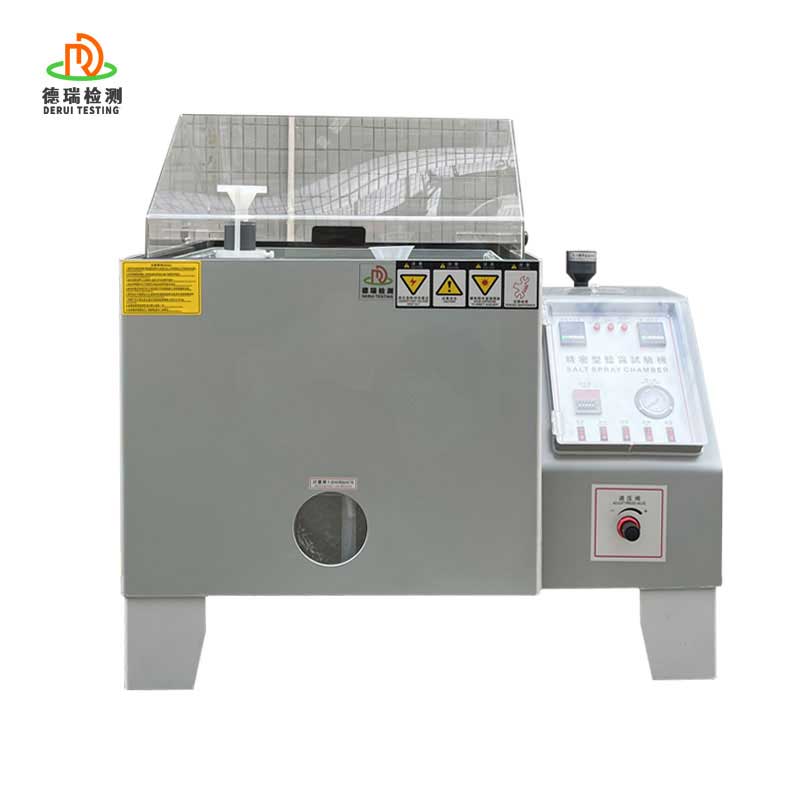- Welcome to, We are a professional factory specializing in the production of testing chamber equipment.
- WhatsApp:+8615112812380
90 Salt Spray Chamber
- 分类: Salt Spray Test Chamber
- |
- 日期: 02/25/2025 21:44
Our Salt Spray Chamber delivers laboratory-grade corrosion testing, compliant with ASTM B117, ISO 9227, and JIS Z 2371 standards. Designed for automotive, aerospace, and electronics manufacturers, it simulates harsh environments to validate coating durability, metal integrity, and material longevity.
- Equipment Material :Both inside & outside shell adopt P.V.C rigid plastic board
- Temperature Range :Room temperature ~ 55℃
- Spraying method :Continuous and Periodic spray type
- Brine Temperature :35℃±1℃
- Spray Quantity :1.0~2.0 ml / 80cm2 / hr
- Brine Tank Capacity :25L
产品详情
Salt Spray Chamber: Precision Corrosion Testing Solutions for Industrial Applications
Industrial components and materials subjected to harsh environmental conditions require rigorous validation to ensure durability and performance. Our Salt Spray Chamber delivers unmatched accuracy and reliability in accelerated corrosion testing, helping manufacturers comply with international standards (ASTM B117, ISO 9227) while streamlining product development cycles.
Key Features & Technical Advantages
- Climate Control Precision
- Digital temperature regulation (15°C to 55°C ±1°C) paired with humidity control ensures consistent test conditions.
- Optional UV irradiation modules simulate real-world solar exposure for comprehensive weathering analysis.
- Customizable Test Chambers
- Available in capacities from 50L to 2,000L, accommodating small prototypes or large-scale assemblies.
- Modular designs allow integration with robotics for automated sample handling and data logging.
- Advanced Corrosion Simulation
- Precise NaCl solution concentration control (5% wt/vol standard, adjustable) with conductivity monitoring.
- Fog generation systems utilizing compressed air atomization minimize salt deposits on test samples.
- Real-Time Data Monitoring
- Integrated IoT-enabled platform provides live tracking of critical parameters (pH, temperature, salt density).
- Exportable test reports include corrosion rate calculations and visual documentation via high-resolution cameras.
- Material Compatibility
- Constructed with corrosion-resistant 316L stainless steel and PTFE linings for extended lifespan.
- Safety features include emergency shutoff valves and gas detection systems for nitric acid-based tests.
Applications Across Industries
- Automotive: Evaluating coating systems for automotive parts under highway humidity conditions
- Aerospace: Accelerated aging of aluminum alloys used in aircraft components
- Electronics: Testing PCBs and connectors for resistance to environmental stressors
- Construction: Validation of coatings for marine infrastructure and building materials
Who Relies on Our Salt Spray Chambers?
Construction: Certify galvanized steel and powder coatings for bridges and offshore rigs.
Automotive OEMs: Validate electroplated components (brake lines, fasteners) against road salt corrosion.
Aerospace: Test aluminum alloy coatings under simulated coastal humidity (per MIL-STD-810G).
Electronics: Assess PCB conformal coatings for marine or industrial applications.
Note: All specifications subject to final configuration. Compliance certifications available upon request.
| Model | DR-H304-90 |
| Internal Size (L×W×H) | 900x600x500mm |
| External Size (L×W×H) | 1410x880x1280mm |
| Equipment Material | Both inside & outside shell adopt P.V.C rigid plastic board |
| Temperature Range | Room temperature ~ 55℃ |
| Temperature Fluctuations | ≤±0.5℃ |
| Temperature Uniformity | ≤±2℃ |
| Temperature Precision | ±1℃ |
| Spraying method | Continuous and Periodic spray type |
| Test Chamber Temperature | Salt Spray Method (NSS ACSS)35±1℃ Corrosion-resistant Testing Method (CASS) 50±1℃ |
| Saturated air Barrel Temperature | Salt Spray Method (NSS ACSS)47±1℃ Corrosion-resistant Testing Method (CASS) 63±1℃ |
| Brine Temperature | 35℃±1℃ |
| Spray Quantity | 1.0~2.0 ml / 80cm2 / hr |
| PH value | Salt Spray Method (NSS ACSS6.5~7.2) Corrosion-resistant Testing Method(CASS)3.0~3.2 |
| Lab Volume | 270L |
| Brine Tank Capacity | 25L |
| Multiple Safety Protection Devices | Current discharge protection, over pressure protection, over temperature protection, over load fuse protection |
| Accessories | Testing Salt/ Measuring tank/Nozzle Equipment x 1 set |
| Air source | 1HP Air pump (provided by buyer) |
Frequently Asked Questions (FAQ): Salt Spray Chambers
Q1: What industries rely on salt spray testing?
A: Salt spray chambers are essential for industries requiring corrosion resistance validation, including:
- Automotive: Testing coatings on brake components, fasteners, and chassis parts.
- Aerospace: Evaluating protective layers on aluminum alloys and turbine components.
- Electronics: Assessing connectors, PCBs, and enclosures for marine or coastal environments.
- Construction: Validating galvanized steel, paints, and coatings for bridges or offshore structures.
Q2: Which testing standards do your chambers comply with?
A: Our chambers meet ASTM B117, ISO 9227, JIS Z 2371, and MIL-STD-810G standards. Customizable settings are available for specialized protocols like CCT (Cyclic Corrosion Testing) or ASTM G85.
Q3: How long does a typical salt spray test take?
A: Test duration varies by material and standard:
- Basic neutral salt spray (NSS): 24–1,000+ hours.
- Acetic acid salt spray (AASS): 96–500 hours.
- Cyclic tests: Multi-phase cycles (spray, humidity, drying) spanning weeks.
Q4: What salt concentration and pH levels are maintained?
A: Our systems use a 5% NaCl solution (pH 6.5–7.2) for NSS tests. For AASS or CASS (copper-accelerated tests), pH is adjusted to 3.1–3.3 with acetic acid. Real-time sensors ensure ±0.1 pH stability.
Q5: How is fog settlement uniformity ensured?
A: Chambers feature:
- Dual-nozzle atomizers for consistent fog distribution.
- V-shaped chamber ceilings to prevent droplet condensation on samples.
- Automatic solution replenishment to maintain concentration accuracy.
Q6: What materials are compatible with salt spray testing?
A: The chamber’s interior is built with 316L stainless steel and PP/PTFE liners to resist acidic/corrosive environments. Avoid testing highly reactive materials like magnesium alloys without consulting our team.
Q7: How often should the chamber be cleaned and calibrated?
A:
- Daily: Drain residual solution and clean nozzles.
- Monthly: Inspect seals and replace air filters.
- Annually: Full calibration (temperature, spray rate, pH sensors) per ISO/IEC 17025 guidelines.
Q8: What safety features are included?
A:
- Leak detection: Alerts for solution overflow or air pressure drops.
- Corrosion-resistant electricals: Sealed components to prevent short circuits.
- Emergency stop: Instantly halts testing in case of malfunctions.
Q9: How do I interpret salt spray test results?
A: Post-test analysis includes:
- Visual inspection: Rust grading per ASTM D610.
- Weight loss measurement: Calculates corrosion rate (g/m²/hour).
- Cross-cut adhesion tests: Assess coating integrity per ISO 2409.
deruitest|chambe
我们是专业的WordPress网站建设团队,提供高品质的WordPress主题。新主题微信公众号:cntestingchamber.com,欢迎热爱WordPress的每一位朋友关注!
© 2025. All Rights Reserved. cntestingchamber.com Theme By XinTheme
















